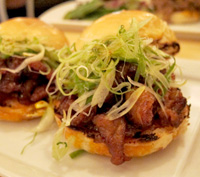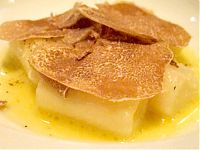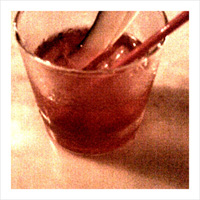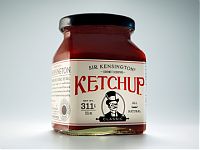Country Cooking
by Everett Hutt
February 5, 2010

For all the sophistication of Parisian restaurants, I truly believe that one eats better in the French countryside. This is not due to better chefs, fresher ingredients or different style of cuisine. Rather it is due to the change of setting. Leave Paris and much of the confined urban space and associated stress dissipate, so you can fully focus on savoring the delicious food in more varied surroundings.
A recent trip to Normandy illustrated that. My brother, his wife and I went for a weekend to visit the WWII Normandy beaches, as well as the stunningly beautiful and moving Normandy American Cemetery and Memorial. Cultural highlights included the always fascinating Bayeux Tapestry and several medieval abbeys. And of course, we ate very well.
The highlight was a dinner at the Chateau d’Audrieu, a Relais & Chateux. This lovely 18th-century chateau has been transformed into a beautiful hotel. There are several gardens in the large park and even a tree house. The dining room is situated on the ground floor in the center of the chateau so that you can see both the entrance forecourt and the gardens behind. The fresh flowers on the table come from the gardens, and if your dinner coincides with sunset, as ours did, the light pierces the dining room, lighting up the gardens behind and creating a spectacular effect.
The dinner more than matched the setting. It started off very well, when the waiter put bread and butter on the table. This part of Normandy and nearby Brittany are renown for their butter, and the artisanal salted butter from master butter maker Jean-Yves Bordier was the surprise star of the evening. As my sister-in-law said, the bread (also delicious) was “just a vehicle for eating the butter.”
With our arteries already happily clogged, we attacked the meal. The highlight of our starters was ginger-infused ravioli stuffed with scampi and lemon. The ginger added an Asian-fusion note to what is otherwise a classic dish. The whole dish had a deft touch to it, with just the right amount of seasoning. The other starters — white asparagus and sea bream carpaccio — were excellent as well. All the primary ingredients were local and the freshness showed.
We tried three very different main dishes: grilled sea bass, roasted pork chest and veal cutlets. The same deft touch pervaded all three dishes, but the veal was the standout. It came with “forgotten vegetables,” a selection of locally grown heirloom vegetables. Some I could identify as variants on beets and parsnips but others I had never seen or tasted. The veal was simply grilled and had a lovely cream sauce whose richness was beautifully cut with a small arugula salad.
By the time we got to cheese and dessert, we were slowing down. We decided on only a cheese plate, sampling a selection of local Norman cheeses: Cœur de Neufchâtel, Pont l’Evêque, Camembert and Livarot. All are creamy cows cheeses, but each has a texture and style all its own. I prefer Livarot as the washed rind adds an extra tanginess.
The wines we had with the dinner were also excellent and, for the most part, beautifully accompanied the dinner. We started with a glass of Brut Champagne “Cuvée Felicien” from Fay-Berjot in the Marne area of Champagne. Composed mostly of Pinot noir grape, it gives this a light, lemongrass taste. It has a vinous style rather than the typical bubbly style of champagnes.
The white wine was a slight misstep. I chose a 2004 Bordeaux Blanc from the celebrated Pauillac red wine producer Chateau Lynch-Bages. I have had this wine before though not the 2004 vintage. Normally a crisp but full-bodied expression of Sauvignon Blanc and Sémillon, this bottle gave a very herbal nose and lots of toasted nuts on the palate. I almost returned it, but decided not to, as on second thought I felt the wine was probably in a closed period. I think it will mellow out nicely in two to five years.
The 2000 Cornas “Les Ruchets” from Jean-Luc Colombo, a bright Syrah from the Rhone suggested by the sommelier, was a return to form. Derived from ancient vines — some over 90 years old — this wine has a full-bodied flavor of black currants with only a light touch of tannins.
And of course after the long meal, we topped off the evening with a glass of Calvados, the indigenous alcohol. Not at all a connoisseur of Calvados, even I was able to appreciate the quality of the 1984 Vieux Domfrontais Calvados from Roger Lemorton. Bottled in only 2003, the nearly 20 years of cask aging had mellowed out the alcohol leaving a pure taste of apples. It was a wonderful end to a great dinner and weekend. And proof positive that one eats at least as well, if not better, in the countryside as in Paris.


















